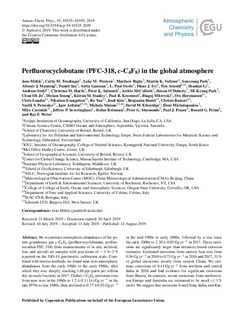| dc.description.abstract | We reconstruct atmospheric abundances of the potent greenhouse gas c-C4F8 (perfluorocyclobutane, perfluorocarbon PFC-318) from measurements of in situ, archived, firn, and aircraft air samples with precisions of ∼1 %–2 % reported on the SIO-14 gravimetric calibration scale. Combined with inverse methods, we found near-zero atmospheric abundances from the early 1900s to the early 1960s, after which they rose sharply, reaching 1.66 ppt (parts per trillion dry-air mole fraction) in 2017. Global c-C4F8 emissions rose from near zero in the 1960s to 1.2±0.1 (1σ) Gg yr−1 in the late 1970s to late 1980s, then declined to 0.77±0.03 Gg yr−1 in the mid-1990s to early 2000s, followed by a rise since the early 2000s to 2.20±0.05 Gg yr−1 in 2017. These emissions are significantly larger than inventory-based emission estimates. Estimated emissions from eastern Asia rose from 0.36 Gg yr−1 in 2010 to 0.73 Gg yr−1 in 2016 and 2017, 31 % of global emissions, mostly from eastern China. We estimate emissions of 0.14 Gg yr−1 from northern and central India in 2016 and find evidence for significant emissions from Russia. In contrast, recent emissions from northwestern Europe and Australia are estimated to be small (≤1 % each). We suggest that emissions from China, India, and Russia are likely related to production of polytetrafluoroethylene (PTFE, “Teflon”) and other fluoropolymers and fluorochemicals that are based on the pyrolysis of hydrochlorofluorocarbon HCFC-22 (CHClF2) in which c-C4F8 is a known by-product. The semiconductor sector, where c-C4F8 is used, is estimated to be a small source, at least in South Korea, Japan, Taiwan, and Europe. Without an obvious correlation with population density, incineration of waste-containing fluoropolymers is probably a minor source, and we find no evidence of emissions from electrolytic production of aluminum in Australia. While many possible emissive uses of c-C4F8 are known and though we cannot categorically exclude unknown sources, the start of significant emissions may well be related to the advent of commercial PTFE production in 1947. Process controls or abatement to reduce the c-C4F8 by-product were probably not in place in the early decades, explaining the increase in emissions in the 1960s and 1970s. With the advent of by-product reporting requirements to the United Nations Framework Convention on Climate Change (UNFCCC) in the 1990s, concern about climate change and product stewardship, abatement, and perhaps the collection of c-C4F8 by-product for use in the semiconductor industry where it can be easily abated, it is conceivable that emissions in developed countries were stabilized and then reduced, explaining the observed emission reduction in the 1980s and 1990s. Concurrently, production of PTFE in China began to increase rapidly. Without emission reduction requirements, it is plausible that global emissions today are dominated by China and other developing countries. We predict that c-C4F8 emissions will continue to rise and that c-C4F8 will become the second most important emitted PFC in terms of CO2-equivalent emissions within a year or two. The 2017 radiative forcing of c-C4F8 (0.52 mW m−2) is small but emissions of c-C4F8 and other PFCs, due to their very long atmospheric lifetimes, essentially permanently alter Earth's radiative budget and should be reduced. Significant emissions inferred outside of the investigated regions clearly show that observational capabilities and reporting requirements need to be improved to understand global and country-scale emissions of PFCs and other synthetic greenhouse gases and ozone-depleting substances. | nb_NO |

